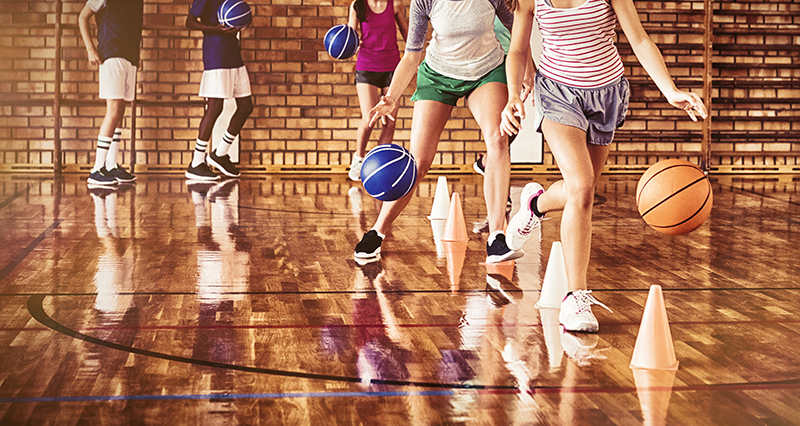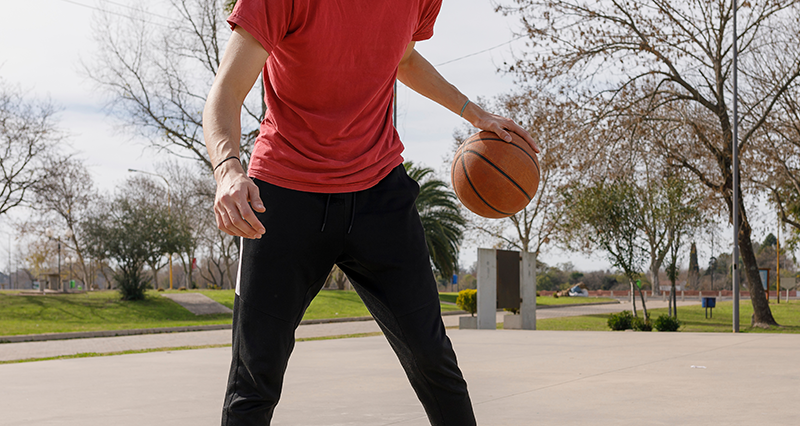Basketball is a fast-paced sport involving the entire body in explosive movements to leap, bound, shoot and block. Before 1950 all shots must be taken with one foot in contact with the ground. This change of rules provides a higher scope for injuries, not only to the lower extremity but also the arm and shoulder in the now popular ‘slam dunk’.
Preventing basketball injuries
Warm-up
One of the best ways of avoiding injury is to ensure a full warm-up is undertaken. This should involve 5-10 minutes of cardiovascular exercise in order to raise the heart rate, increase the body and muscle temperature and improve muscle elasticity. This should be followed by stretching exercises which are usually a combination of active and static stretches. The key areas to stretch are the muscles of the legs (including the buttocks) as well as the pectorals and shoulder musculature. Skill drills are then usually incorporated to prepare a player mentally as well as enhancing their coordination and motor performance.
Strength
Strength and power are important in both basketball performance, as well as injury prevention. A player must have the basic whole-body strength to be able to perform the demanding moves required for basketball with some efficiency. Inefficient movement is one of the fastest tracks to injury. Due to the explosive nature of the game, plyometrics are often used to improve performance. These are explosive drills using jumps and bounds, often from a height.
Conditioning
As with all sports, the player must be fit for the specific task in question. This not only relates to the sport but also the player’s position and role within the team. Basketball is played in 12 minute periods, throughout which a player must perform repeated bouts of strenuous exercise with very little rest in-between. An excellent aerobic (low intensity) base should be maintained during the offseason, which can be developed during pre-season into anaerobic fitness. This is done with the use of interval sessions, where a short burst of intense exercise is interspersed with rest periods. If a player is not fit for the sport then fatigue kicks in and fatigue leads to injury.
Equipment
Basketball players wear very little in the way of protective clothing. The most common items are knee and elbow pads which protect these areas from abrasions and bruising in the event of a fall. In a bid to avoid ankle injuries, in particular, consideration should be given to the use of low or high-top basketball shoes. Research has shown that high-top shoes result in a lower incidence of ankle sprains. Taping and braces are also used regularly, especially by those with previous ankle injuries. These too have been shown to reduce the rate of injury.
Common Basketball Injuries
Most basketball-related injuries are strains (muscle tears), sprains (ligament tears) or contusions (muscle damage through impact). The most frequently injured area is the ankle, followed by the knee. Up to 92% of basketball players will suffer an ankle sprain at least once in their playing career.
Sprained ankle
A sprained ankle occurs when the player rolls the ankle, usually so that the sole of the foot faces inwards. This is a lateral ankle sprain and causes damage to the anterior talofibular ligament and sometimes also the calcaneofibular ligament. The ankle must be inspected thoroughly and is usually x-rayed to rule out a fracture. After using the RICE protocol to reduce pain and swelling, a full rehabilitation program should be commenced to restore full movement and strength to prevent a reoccurrence. Learn more about sprained ankles.
Achilles tendinitis
The Achilles tendon is the large, thick tendon at the back of the ankle, which connects the calf muscles to the heel bone. Due to the repetitive jumping and bounding involved in basketball, the Achilles tendon is put under a lot of strain. Symptoms include pain, swelling, redness and a thickening of the tendon. If left untreated this can evolve into a chronic injury, leaving the player more susceptible to a complete rupture. Find out more about Achilles tendinitis.
Patella tendinitis
Patella tendinitis is also known as jumper’s knee due to its prevalence in sports people involved in repetitive jumping. Basketball is no exception as the jumping and bounding movements can cause micro-tears to the tendon, resulting in pain directly underneath the knee. Again, leaving this injury to run its course can result in more significant damage. Learn more about patella tendinitis.
Meniscus (cartilage) injuries
The meniscus is two discs of cartilage which help with shock absorption and smooth movement of the knee. They are situated on the flat, top surface of the Tibia (shin bone), within the knee joint. Tears to one of these discs (medial or lateral) occur most frequently with pivoting and cutting maneuvers. The player will usually complain of pain and either locking or instability of the knee. Find out more about meniscus injuries.
Knee ligament injuries
The most frequently damaged ligaments are the anterior cruciate ligament (ACL) and the medial collateral ligament (MCL). In basketball, they are most often caused by twisting motions applied to the knee when the foot is planted on the floor. They can also be injured from an impact, such as another player landing on the joint, causing an awkward fall. Learn more about MCL and ACL injuries.
Hamstring strains
The hamstrings are the muscle group that forms the back of the thigh. They are commonly injured in sports involving sudden bursts of speed. When this happens the hamstrings must act eccentrically to decelerate the forward motion of the tibia (shin bone). It is at this point that the hamstrings are most commonly injured. Hamstring strains can be graded 1-3 as with all muscle strains. Grade 3 is a full rupture. Find out more about hamstring strains.
Contusions
Contusions usually occur as a result of strong contact with another player’s elbow or knee. This causes damage to the blood vessels within the muscles, where it is compressed against the underlying bone. The extent of the damage depends on the depth of the contact, but all contusions should be treated with respect with the RICE protocol being applied immediately. If not treated properly, a deep contusion could result in myositis ossificans. Learn more about contusions.
Hand and finger injuries
Injuries to the hand and fingers can be caused by the ball or by catching the fingers in the net during a shot. Damage can either be ligamentous (to the collateral ligaments of the fingers for example) or bony, with fractures to the fingers occurring more regularly than in most other sports. Read more about hand and finger injuries.



